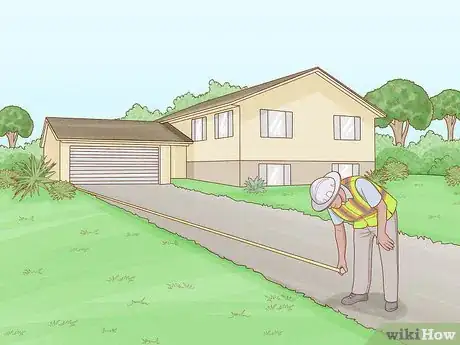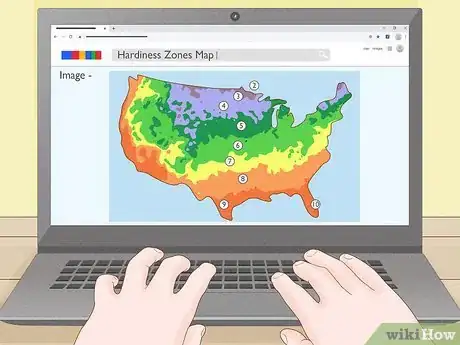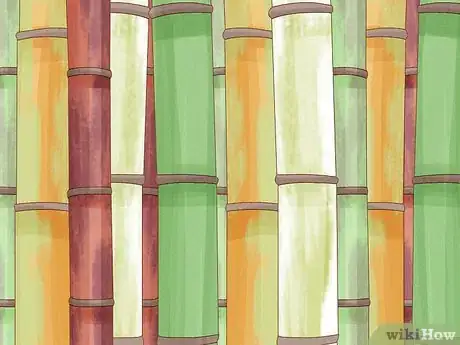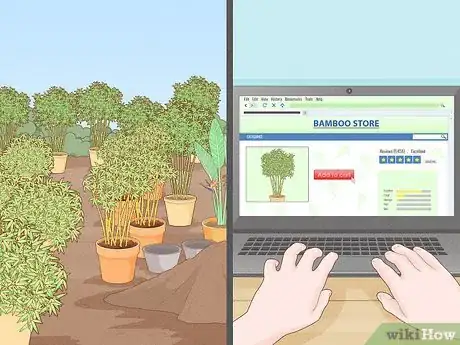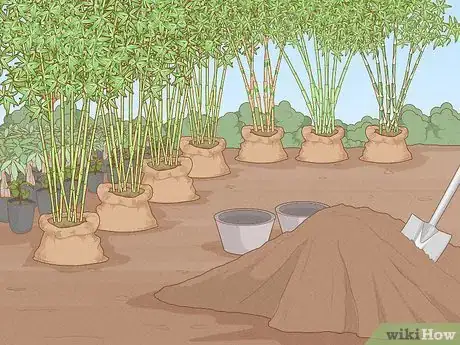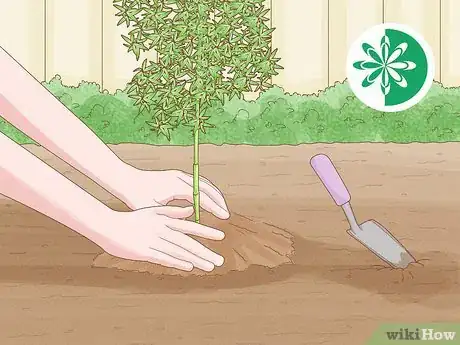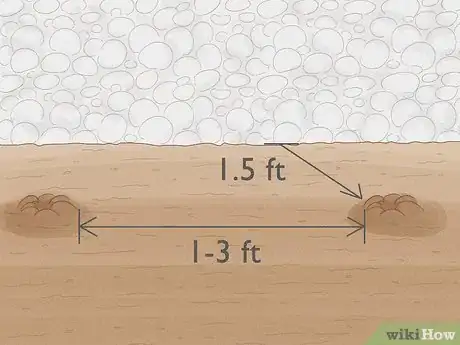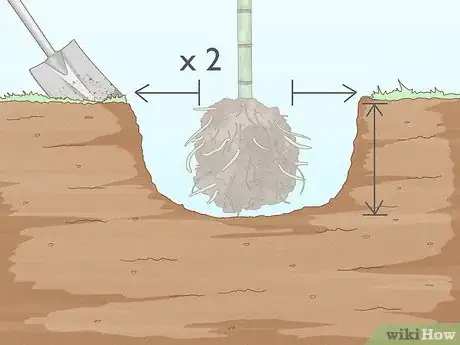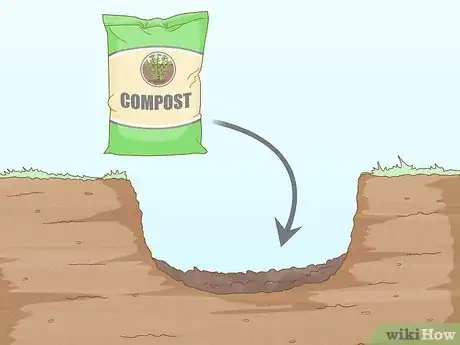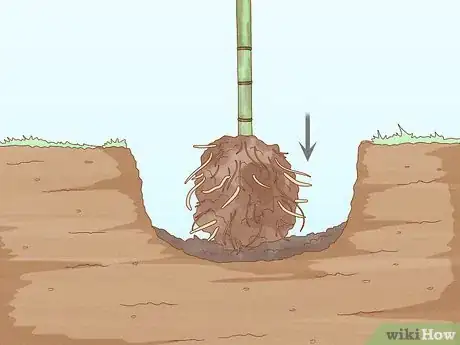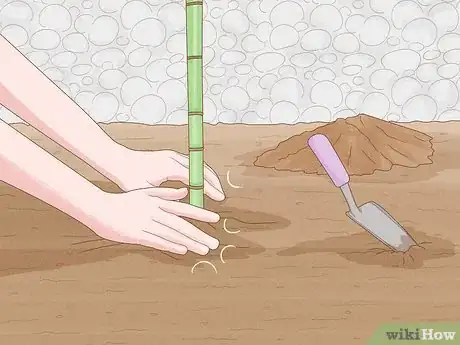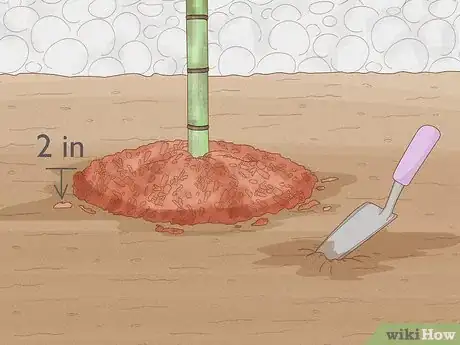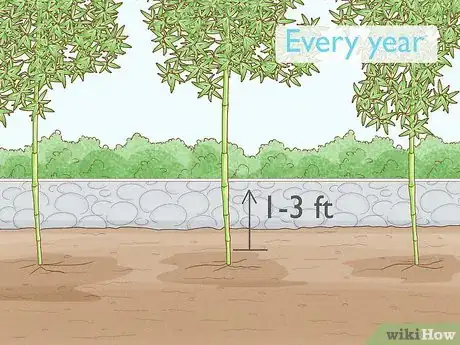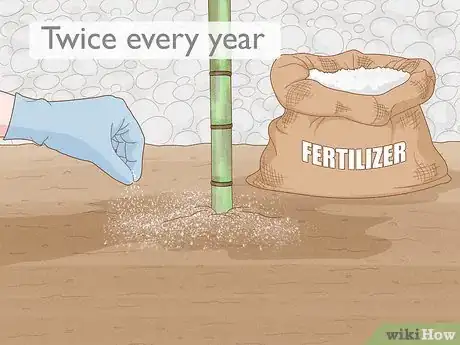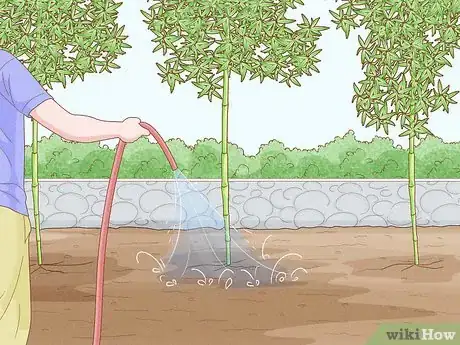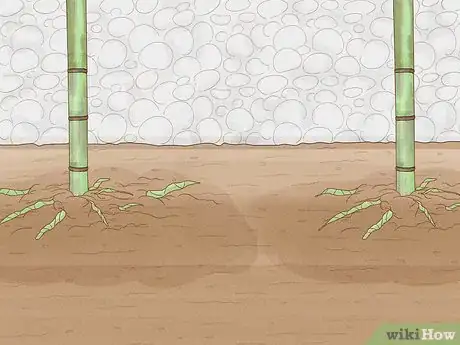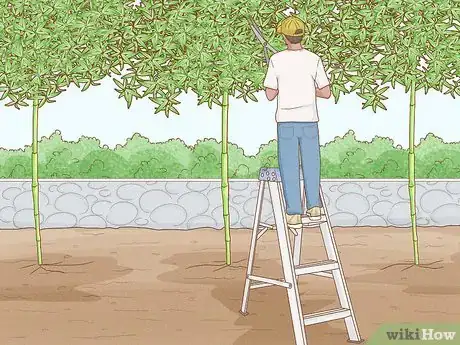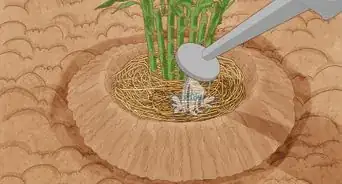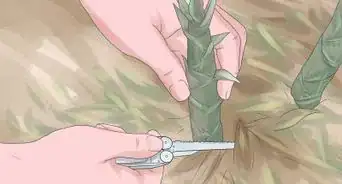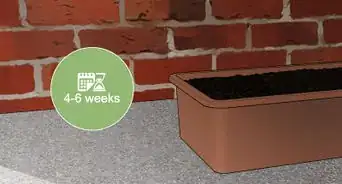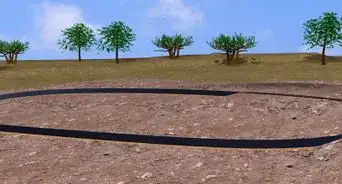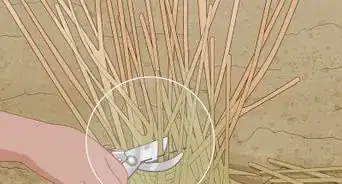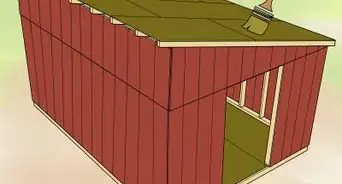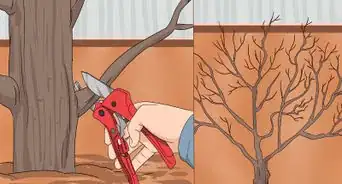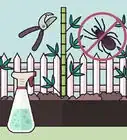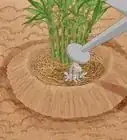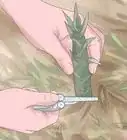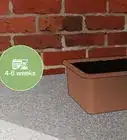X
wikiHow is a “wiki,” similar to Wikipedia, which means that many of our articles are co-written by multiple authors. To create this article, volunteer authors worked to edit and improve it over time.
There are 7 references cited in this article, which can be found at the bottom of the page.
This article has been viewed 38,329 times.
Learn more...
Bamboo is a fast growing woody grass with over 1000 species. Because of it's rapid growth and potential to spread, bamboo is both adored and detested. With proper consideration, bamboo can be utilized as a natural barrier or fence in your yard that is both good for the environment and beautiful.
Steps
Part 1
Part 1 of 3:
Planning
-
1Find and measure the right location to plant your bamboo fence. The recommended distance from any underground structure is 1.5 ft. This prevents the root from causing any problems.
- Always call (811) before any project that involves digging more than 6" below the ground.
- Bamboo typically prefers partial to full sun.
- Bamboo needs a similar amount of water as your average lawn grass.
- It needs a well drained soil. Avoid swampy places.
-
2Determine your hardiness zone and the bamboo species that will thrive in your zone.[1] Look through bamboo databases to find species that thrive within that zone.[2]Advertisement
-
3Decide if running (leptomorph) bamboo or clumping (pachymorph) bamboo is right for you.
- Running bamboo grows quicker and easier, but is likely to spread to undesired areas. Due to this, running bamboo should be potted or surrounded by well built, underground barriers.
- Clumping bamboo grows slower but is much easier to control, and therefore the advised choice.
-
4Determine the size of bamboo fence that you would like. Bamboo can reach a max height anywhere from 2 ft - 100 ft. Websites and other databases typically provide a maximum growth height for each species.[3]
- Maximum height is only reached in ideal conditions and after many years. Typically, your bamboo will not reach maximum height, only ~70% of maximum height.
-
5Choose the aesthetic. Bamboo comes in a variety of stem and leaf colors.
- In some species of bamboo, leaves turn color in autumn and fall off. Others maintain their leaf color year round.
- Different shapes are found in different species. The largest factor in determining the shape is whether it is a clumping or running bamboo, though among each type variation does exist.
-
6Find a store that sells bamboo. You may wish to search local nurseries or visit an online retailer.
-
7Determine the maturity of the plant you wish use. Younger plants are much cheaper, though will require at least 3 years before they near a mature height. Bamboo plants do not often produce seeds, so this article will focus on using potted plants.
-
8Reference an example. Understanding how all of these factors come into play for your chosen species can be easier if you look at an example. Here are the necessary details to consider for the bamboo species Fargesia denudata:[4]
- It is a shade loving species
- It is hardy in USDA zones 4-9. Detroit is in zone 6b.
- It is a clumping variety, so there is much less worry of spread to neighbors' yards.
- It has a maximum height of 15 ft, which means an expected max in Detroit of 6-9 ft
- The foliage stays green year round
- It is common, and therefore cheap ($20 for 1-3 ft tall plant)
Advertisement
Part 2
Part 2 of 3:
Planting
-
1Decide when to plant. Younger, shade-loving bamboo are sensitive to strong sunlight. Plant these in spring to allow time to grow.
- Recently planted bamboo will fall victim to the summer afternoon sun and bamboo needs time to establish itself before enduring the winter.
- In warmer climates, bamboo may be planted in the fall.
-
2Measure where plants will go. Planting bamboo too close together is not a big issue. For a dense fence using young bamboo, allow 1-3 ft between each potted plant.The hole diameter will be 2x the diameter of the root ball.
- Try to keep the bamboo 1.5 ft away from any permanent underground structure. Bamboo roots are very strong and can go through most things.
-
3Prepare the hole. *The diameter of the hole should be 2x that of the root ball. The depth of the hole should equal the height of the root ball plus a few inches.
-
4Fill bottom of hole in with organic material, like compost.
-
5Place bamboo plant in hole.
-
6Fill in hole with soil. Use a mix of both the compost and local soil. Overall, 50% compost or organic material will make for a very happy bamboo plant. Top of root-ball (root-mass) should be level with surface.
-
7Add mulch on top of soil. 2 or more inches is best. This helps retain moisture (bamboo loves water).
- Unlike trees, you may put the mulch up to the stem of the bamboo plant. Bamboo is a forest plant, it likes to have it's roots covered by more than soil.
Advertisement
Part 3
Part 3 of 3:
Maintaining the Plant
-
1Expect growth. Average growth is 1-3ft per year. Some species can grow up to 10ft in a year.
- For each shoot that now exists, expect a new one to sprout next year. If your bamboo plant has 5 shoots, expect to have 10 next year.
-
2Fertilize twice per year. Use a well-balanced fertilizer (10-10-10) like that used for grass.
-
3Water your bamboo. Water more when it is becoming established, 1-2 times weekly for the first 3-6 months.
- Provide similar volume of water to lawn grass.
- Make sure soil is well drained.
- Mulch - like leaves, grass trimmings, or wood chips - help retain moisture and reduce need for watering.
-
4Watch for spread of roots (rhizomes).
- Check running bamboo roots 2x per year; trim if necessary.
- Check clumping bamboo every other year; trim if necessary.
-
5Prepare for the winter.
- Make sure roots are covered with a thick layer of mulch (~3")
-
6Trim, primarily for aesthetics. If you want a bushy plant, trim less. If you want a thin plant, trim away. Wherever cut is made, growth is permanently halted.
- Trim in late summer or fall.
- Cut above nodes.
Advertisement
Warnings
- Due to the the root structure of running bamboo, it is able to cross almost any boundary within a few years and send up fresh shoots. Many species of bamboo are considered very invasive and as such, planting regulations for bamboo exist in many states. Please practice caution if using running bamboo and consider keeping it in pots. Even clumping bamboo must be carefully watched.⧼thumbs_response⧽
Advertisement
Things You'll Need
- Shovel
- Compost
- Bamboo transplants
- Measuring device
- Rake
References
- ↑ http://planthardiness.ars.usda.gov/PHZMWeb/
- ↑ http://www.bamboogarden.com/Bamboo%20categories.htm
- ↑ http://planthardiness.ars.usda.gov/PHZMWeb/
- ↑ ttp://www.bamboogarden.com/Fargesia%20denudata.htm>
- https://lewisbamboo.com/knowledge-base/frequently-asked-bamboo-questions/
- http://tcpermaculture.com/site/2014/01/13/permaculture-plants-bamboo/
- http://www.bamboobotanicals.ca/html/about-bamboo/bamboo-growth-habits.html
- http://www.care2.com/greenliving/5-reasons-not-to-plant-bamboo-in-your-yard.html
About This Article
Advertisement
